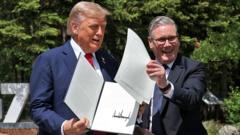As Canadians cast their votes today, April 28, 2025, the highly anticipated election raises critical questions regarding the nation's economic future and its stance amidst President Trump's controversial trade policies. Polls this morning indicated a close race between the incumbent Liberal Party, led by Prime Minister Mark Carney, and the Conservative Party under Pierre Poilievre. Just three months ago, the Conservative Party was anticipated to glide into victory, holding an overwhelming lead of over 25 percentage points; however, the resignation of Justin Trudeau and Trump's aggressive economic policies have reshaped the electoral landscape.
Canada's Election: How Trump's Policies Shape the Race for Prime Minister

Canada's Election: How Trump's Policies Shape the Race for Prime Minister
Amid a burgeoning trade war, Canadians head to the polls to choose between two distinctly different candidates, with President Trump's influence weighing heavily on the campaign.
While three additional parties—the New Democrats, Greens, and Bloc Quebecois—are on the ballot, they are not positioned to secure a significant number of seats in the House of Commons. More than 343 seats will be contested today, with the winning party leader becoming the prime minister.
Mark Carney, a seasoned central banker and the new figurehead of the Liberal party, has positioned himself as someone capable of tackling Trump's tariffs and economic strategies. In stark contrast, Poilievre aligns with neoliberal ideals, advocating for reduced regulations and government size—a stance that reflects Trump's influence, earning him criticism for perceived similarities.
Voter turnout appears strong, with around 7.2 million Canadians participating in advance voting. Amid efforts to appeal to diverse communities in Canada, crucial issues such as the economy and the country's sovereignty are dominating voter conversations, especially regarding how to handle Trump's tariff threats.
Election polling hours span from 7 a.m. to 9:30 p.m. Eastern Time, with results expected to be reported late tonight—after counting each paper ballot by hand across the country’s six time zones. Tracking the final outcome will unveil if Carney can maintain a hold on public confidence or if Poilievre can capitalize on a resurgence in Conservative popularity amidst economic uncertainties.
As Canadians emerge from the polling stations, the ramifications of today's election extend far beyond party allegiances—shaping the future of Canada’s national identity amid a tumultuous relationship with its southern neighbor.
Mark Carney, a seasoned central banker and the new figurehead of the Liberal party, has positioned himself as someone capable of tackling Trump's tariffs and economic strategies. In stark contrast, Poilievre aligns with neoliberal ideals, advocating for reduced regulations and government size—a stance that reflects Trump's influence, earning him criticism for perceived similarities.
Voter turnout appears strong, with around 7.2 million Canadians participating in advance voting. Amid efforts to appeal to diverse communities in Canada, crucial issues such as the economy and the country's sovereignty are dominating voter conversations, especially regarding how to handle Trump's tariff threats.
Election polling hours span from 7 a.m. to 9:30 p.m. Eastern Time, with results expected to be reported late tonight—after counting each paper ballot by hand across the country’s six time zones. Tracking the final outcome will unveil if Carney can maintain a hold on public confidence or if Poilievre can capitalize on a resurgence in Conservative popularity amidst economic uncertainties.
As Canadians emerge from the polling stations, the ramifications of today's election extend far beyond party allegiances—shaping the future of Canada’s national identity amid a tumultuous relationship with its southern neighbor.





















